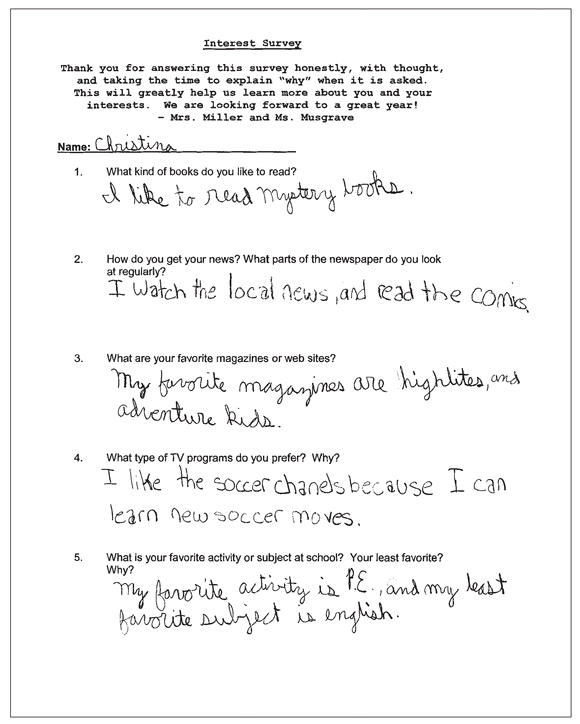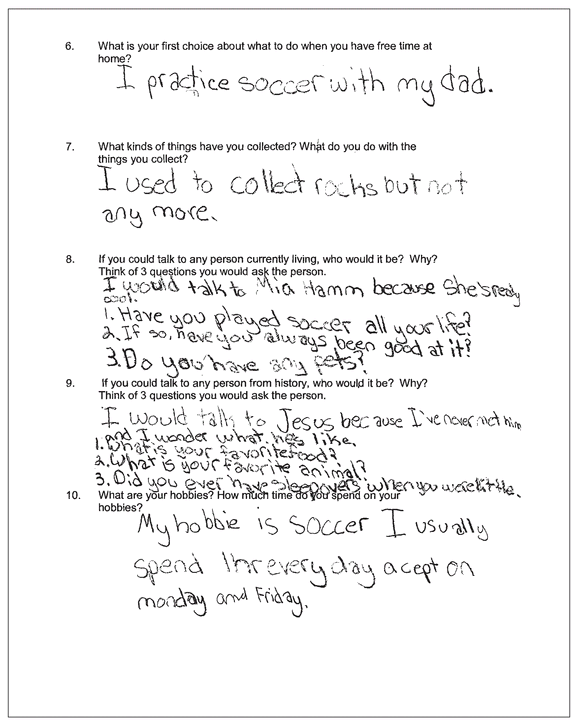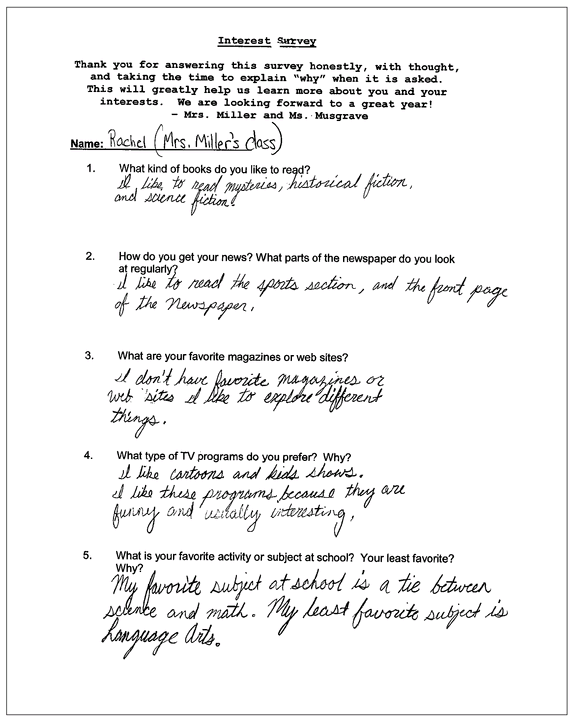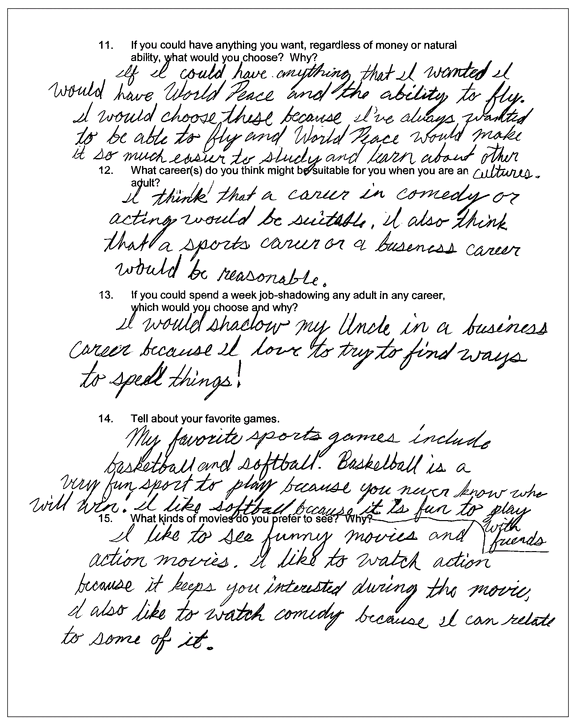The Book Whisperer (6 page)
Read The Book Whisperer Online
Authors: Donalyn Miller,Jeff Anderson

I no longer spend the majority of my planning time crafting those glorious novel units. Instead, I focus my efforts on designing a classroom environment that engages my students, based on Cambourne's conditions for learning. We can spend hours determining what students should know and be able to do, crafting instruction to accomplish the desired results, but without considering students' right to an engaging, trustworthy, risk-free place in which to learn, what we teach will always fall short. Students must believe that they can read and that reading is worth learning how to do well. We have to build a community that embraces every student and provides acceptance and encouragement no matter where students are on the reading curve.

WHISPER
Student Surveys
SIGHING, I SHUT MY DOOR at the end of the day and enjoy the quiet of my second home, my classroom. It is the first week of school, and unaccustomed to talking and standing all day, my throat and feet are sore. I wander over to my desk, collapse a little too hard into my chair, and begin thumbing through the surveys my new students filled out in class.
Two piles await me. One is a stack of Reading Interest-A-Lyzer surveys. Created by Sally Reis, based on a form by Joseph S. Renzulli, the surveys ask students to describe their reading habits and their ideal language arts class. The other stack contains general interest surveys, modified versions of a survey created by Susan Weinbrenner (see
Figure 2.1
and
2.2
). Topics range from students' preferences in books, movies, and television programs to which famous people they would like to interview. Teachers frequently use interest surveys as a means to gain insight into the preferences and personalities of their students. In addition, I analyze these surveys for information that will help me encourage my students to read.
Figure 2.1
and
2.2
). Topics range from students' preferences in books, movies, and television programs to which famous people they would like to interview. Teachers frequently use interest surveys as a means to gain insight into the preferences and personalities of their students. In addition, I analyze these surveys for information that will help me encourage my students to read.
In order to make personal reading recommendations to my students, I need to learn about their past reading experiences and their interests both in and out of school. I mine these surveys for nuggets of information that will form the basis for book recommendations. Students may not be able to describe what types of books they might like to read, but if I have knowledge of their personal interests, I will be able find books that match a topic they enjoy.
Source: Christina, grade 6.


Source: Rachel, grade 6.


Shutting out the sounds of lockers slamming shut from the hallway, I focus on what whispers to me from their words. How can I reach each one through books? What books can I recommend that will inspire them to read more? What insight can I glean from the answers they have so dutifully recorded? Holding each child in my mind as I read, I try to match my initial observations of them with their written comments.
Â
Christina
She is bouncy like Tigger, with an easy laugh and a cheerful personality. Even her ponytail bounces. Christina is smart, but she is already learning to mask her intelligence in the manner that so many adolescent girls do. I have noticed that she is not that enthusiastic about reading. Scanning her survey, I look for clues that will help me find enticing books for her.
What type of TV programs do you prefer? Why?
I like the soccer channels because I can learn new soccer moves
.
.
What is your first choice about what to do when you have free time at home?
I practice soccer with my dad
.
.
If you could talk to any person currently living, who would it be? Why?
I would talk to Mia Hamm because she is really cool
.
.
Identifying Christina as a soccer fanatic is an understatement. She even lists Argentina as the country she would most like to visit because, she explained later, they have an “awesome” soccer team! I also notice that she lists English as her least favorite subject. Connecting her with books that tie in with her love for soccer is my obvious first step. Thinking for a moment, I remember that I purchased an
Eyewitness: Soccer
book over the summer because so many students in my class last year expressed an interest in the sport. Finding the book, I jot a note on a Post-it, asking Christina if she would like to be the first to read it. Since she is in my morning class, I walk over to her desk and put the book and note on top.
Eyewitness: Soccer
book over the summer because so many students in my class last year expressed an interest in the sport. Finding the book, I jot a note on a Post-it, asking Christina if she would like to be the first to read it. Since she is in my morning class, I walk over to her desk and put the book and note on top.
Â
Rachel
Rachel is smart, like Christina, but she doesn't care if everyone knows it. Confident and easygoing, with a sharp wit, Rachel is a student others gravitate toward. I think she is good at being a social chameleon. She fits in well with other kids, but I wonder whether she shows much of who she really is. I wonder about this because it is hard to pin down her preferences from her survey answers (see
Figure 2.2
).
Figure 2.2
).
If you could have anything you want, regardless of money or natural ability, what would you choose?
If I could have anything that I wanted I would have World Peace and the ability to fly....
What career(s) do you think might be suitable for you when you are an adult?
I think that a career in comedy or acting would be suitable. . . .
Although Rachel would pack books on a fifteen-year trip in space and spends time reading with her family, she lists language arts as her least favorite class. I wonder what the story is there. Perhaps she is an underground reader who has separated her reading life from her school life. I know from talking to her that she did not read much last year. If I could get her to read more, her influence with other students would help spread the reading vibe. I walk over to the class library across the room and start building a preview stack for Rachel, pulling books about kids like her, kids who have more to them than meets the eye: Paul from
Tangerine
,
Wringer's
Palmer,
The Misfits'
Bobby and Addie, and my favorite loser-hero, Alfred Kropp. I build a tower of books and put them on her desk, too. She can preview the stack tomorrow and choose which books appeal to her.
Tangerine
,
Wringer's
Palmer,
The Misfits'
Bobby and Addie, and my favorite loser-hero, Alfred Kropp. I build a tower of books and put them on her desk, too. She can preview the stack tomorrow and choose which books appeal to her.

I continue this process for an hour, channeling my gut and heart observations of the children, reading and rereading surveys, wandering back and forth in front of our book bins and grabbing book after book after book. For students in my morning class, I stack books right on their desk. For the afternoon group, I line the counter behind my desk with piles of books, Post-its marking the intended recipients. I will continue tomorrow and every day after until I have made preview stacks or pulled select titles for all sixty of my new students. Their needs as readers, as people, call to me from the pages of those surveys, and I whisper back with books.
CHAPTER 3
There's a Time and a Place
No matter how busy you may think you are, you must
find time for reading, or surrender yourself to
self-chosen ignorance.
find time for reading, or surrender yourself to
self-chosen ignorance.
âAtwood H. Townsend
Â
I read in class and that influences me reading everywhere else.âMarilyn
Â
Â
S
ITTING CROSS-LEGGED on my bed, covers up to my chin, I am reading Anna Quindlen's
Black and Blue
, the story of a woman in an abusive marriage. The book is well written and riveting, and I just can't put it down. An annoying knock at the door pulls me out of my book, and I call out two words familiar to my loved ones: “Last chapter!” Swap Quindlen's novel for E. L. Doctorow's historical narrative
Ragtime
, and it could be me two decades ago. No matter what else I may have to doâgrade papers, fold laundry, or catch up on e-mailsâthe siren call of my books is always there, luring me back. Reflecting on her own lifelong obsession with reading, Quindlen writes in
How Reading Changed My Life
, “Books are the plane, and the train, and the road. They are the destination, and the journey. They are home.” I know that my life is marked by the road signs of my beloved books, each one symbolizing who I was when I read it, shaping who I have become. The uninitiated might say that I am lost in my books, but I know I am more found than lost.
ITTING CROSS-LEGGED on my bed, covers up to my chin, I am reading Anna Quindlen's
Black and Blue
, the story of a woman in an abusive marriage. The book is well written and riveting, and I just can't put it down. An annoying knock at the door pulls me out of my book, and I call out two words familiar to my loved ones: “Last chapter!” Swap Quindlen's novel for E. L. Doctorow's historical narrative
Ragtime
, and it could be me two decades ago. No matter what else I may have to doâgrade papers, fold laundry, or catch up on e-mailsâthe siren call of my books is always there, luring me back. Reflecting on her own lifelong obsession with reading, Quindlen writes in
How Reading Changed My Life
, “Books are the plane, and the train, and the road. They are the destination, and the journey. They are home.” I know that my life is marked by the road signs of my beloved books, each one symbolizing who I was when I read it, shaping who I have become. The uninitiated might say that I am lost in my books, but I know I am more found than lost.
Other books
Sex and the Social Network by Lexington, Victoria
Panama by Shelby Hiatt
Math for Grownups by Laura Laing
Garlic and Sapphires by Ruth Reichl
Blackstone and the Heart of Darkness by Sally Spencer
Janus' Conquest by Dawn Ryder
The Death Seer (Skeleton Key) by Tanis Kaige, Skeleton Key
Hammer Down: Children of the Undying: Book 2 by Moira Rogers
Palm Beach Nasty by Tom Turner
Prisoner of Desire by Jennifer Blake